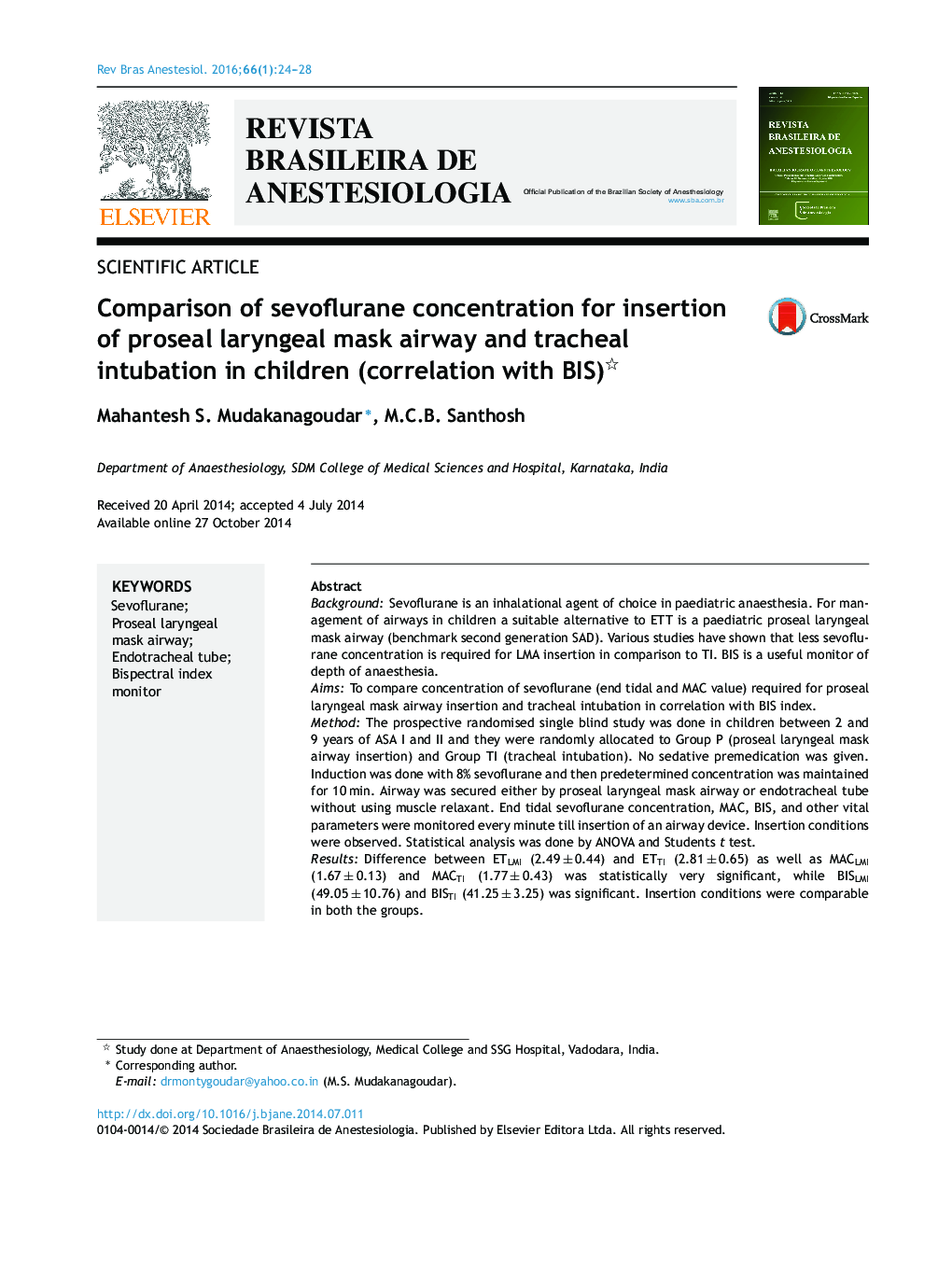| کد مقاله | کد نشریه | سال انتشار | مقاله انگلیسی | نسخه تمام متن |
|---|---|---|---|---|
| 2750106 | 1567300 | 2016 | 5 صفحه PDF | دانلود رایگان |

BackgroundSevoflurane is an inhalational agent of choice in paediatric anaesthesia. For management of airways in children a suitable alternative to ETT is a paediatric proseal laryngeal mask airway (benchmark second generation SAD). Various studies have shown that less sevoflurane concentration is required for LMA insertion in comparison to TI. BIS is a useful monitor of depth of anaesthesia.AimsTo compare concentration of sevoflurane (end tidal and MAC value) required for proseal laryngeal mask airway insertion and tracheal intubation in correlation with BIS index.MethodThe prospective randomised single blind study was done in children between 2 and 9 years of ASA I and II and they were randomly allocated to Group P (proseal laryngeal mask airway insertion) and Group TI (tracheal intubation). No sedative premedication was given. Induction was done with 8% sevoflurane and then predetermined concentration was maintained for 10 min. Airway was secured either by proseal laryngeal mask airway or endotracheal tube without using muscle relaxant. End tidal sevoflurane concentration, MAC, BIS, and other vital parameters were monitored every minute till insertion of an airway device. Insertion conditions were observed. Statistical analysis was done by ANOVA and Students t test.ResultsDifference between ETLMI (2.49 ± 0.44) and ETTI (2.81 ± 0.65) as well as MACLMI (1.67 ± 0.13) and MACTI (1.77 ± 0.43) was statistically very significant, while BISLMI (49.05 ± 10.76) and BISTI (41.25 ± 3.25) was significant. Insertion conditions were comparable in both the groups.ConclusionWe can conclude that in children airway can be secured safely with proseal laryngeal mask airway using less sevoflurane concentration in comparison to tracheal intubation and this was supported by BIS index.
ResumoJustificativaSevoflurano é um agente inalatório de escolha em anestesia pediátrica. Para o manejo de vias aéreas em crianças, uma alternativa adequada para o TET é uma MLP pediátrica (referência de segunda geração SAD). Vários estudos mostraram que uma menor concentração do sevoflurano é necessária para a inserção da ML em comparação com a IT. O BIS é um monitor útil da profundidade da anestesia.ObjetivosComparar a concentração de sevoflurano (valores ao final da expiração e da CAM) necessária para a inserção de MLP e intubação traqueal em correlação com o BIS.MétodoEstudo prospectivo, randômico e cego conduzido com crianças entre 2-9 anos de idade, estado físico ASA I-II, randomicamente alocados nos grupos P (inserção de MLP) e IT (intubação traqueal). Pré-medicação sedativa não foi administrada. A indução foi realizada com sevoflurano a 8% e, em seguida, a concentração predeterminada foi mantida durante 10 min. A via aérea foi garantida por MLP ou tubo endotraqueal, sem o uso de relaxante muscular. A concentração de sevoflurano ao final da expiração, CAM, BIS e outros parâmetros vitais foram monitorados a cada minuto até a inserção do dispositivo respiratório. As condições de inserção foram observadas. A análise estatística foi realizada com o teste-t de Student e ANOVA.ResultadosAs diferenças entre TEIML (2,49 ± 0,44) e TEIT (2,81 ± 0,65), bem como CAMIML (1,67 ± 0,13) e CAMIT (1,77 ± 0,43) foram estatisticamente muito significativas; enquanto BISIML (49,05 ± 10,76) e BISIT (41,25 ± 3,25) foram significativos. As condições de inserção foram comparáveis em ambos os grupos.ConclusãoPodermos concluir que a MLP em comparação com a intubação traqueal pode ser segura para a via aérea de crianças, usando menos concentração de sevoflurano, o que foi confirmado pelo BIS.
Journal: Brazilian Journal of Anesthesiology (English Edition) - Volume 66, Issue 1, January–February 2016, Pages 24–28